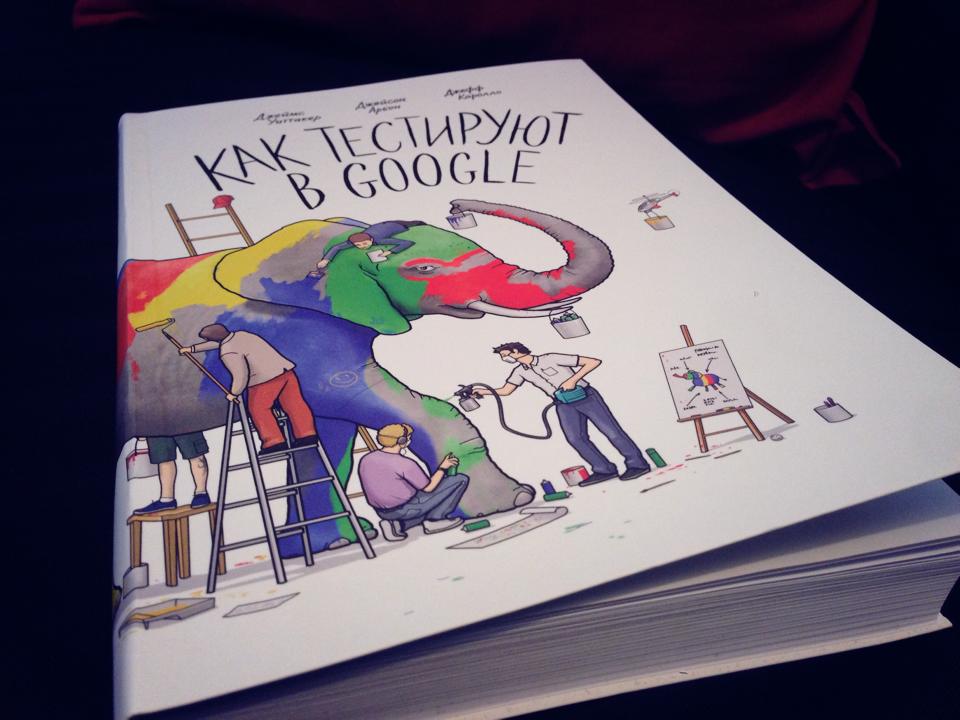The book “How Google Tests Software” is now in Russian!
A year and a half ago, when the book “ How Google Tests Software ” was published, I was set on fire to translate it into Russian. I have long admired Whittaker, I translated his articles , listened to master classes and consider him the coolest man in testing. Then I still worked as the head of the testing department at Innova, and the company supported my project.
Since then, much has changed: I stopped testing, released applications for iOS, now I work as a product manager for a large web project. Whittaker left Google for Microsoft in 2012, slamming the door .
Despite all this, all last year I worked on a book: I negotiated with the publisher, tried to organize a group of volunteers to translate the text (did not work), searched for a translator, helped translate and edit the text, worked with designers on the layout and cover, asserted proofreading and compiled layouts. The project took much more time and effort than I expected, but I was pleased with the result.
')
And so, in January, the publishing house “Peter” published a book in Russian with our translation and design:

Here you can see the table of contents, and here - part of the second chapter.
The book is sold on Ozone : and, in addition, it can be downloaded in electronic form for only 99 rubles (thanks to the publisher, that it went to meet us with the price).
I wanted to make the book so that I myself wanted to read it. Cover artwork Max Degtyarev. His illustrations always want to consider. (Most of the books about testing are decorated with bits and bytes, automation is depicted in the form of robots, and bugs in the form of bugs. I do not want to consider.)
We did not invent mythic analogs of the words "framework", "commit", "bug" and "feature". As we say - so we write. In the book, Google developers and testers talk about their work as if they were sitting opposite. We tried to keep this feeling.
The coolest thing in this book is that it is not really about testing. It is about the development, about the processes, about hiring people, about the company's strategy, about responsibility, about love for work, about the result to which one should strive. About the fact that one quality testing will not achieve. The authors talk about their path, do not hesitate to make mistakes and share the results. The book should be read by both testers, developers, and managers, because it is necessary to paint an elephant from all sides.
This project is very personal to me. I consider it my swan song in testing. Thanks to "Innovation" that the project took place. The best result for me will be if, in as many development teams as possible, they start “testing as in Google,” competently applying the principles to their context.
A small announcement: we will present the book to all participants of the Agile Days conference. Read, light up and make your development cooler!
Since then, much has changed: I stopped testing, released applications for iOS, now I work as a product manager for a large web project. Whittaker left Google for Microsoft in 2012, slamming the door .
Despite all this, all last year I worked on a book: I negotiated with the publisher, tried to organize a group of volunteers to translate the text (did not work), searched for a translator, helped translate and edit the text, worked with designers on the layout and cover, asserted proofreading and compiled layouts. The project took much more time and effort than I expected, but I was pleased with the result.
')
And so, in January, the publishing house “Peter” published a book in Russian with our translation and design:

Here you can see the table of contents, and here - part of the second chapter.
The book is sold on Ozone : and, in addition, it can be downloaded in electronic form for only 99 rubles (thanks to the publisher, that it went to meet us with the price).
I wanted to make the book so that I myself wanted to read it. Cover artwork Max Degtyarev. His illustrations always want to consider. (Most of the books about testing are decorated with bits and bytes, automation is depicted in the form of robots, and bugs in the form of bugs. I do not want to consider.)
We did not invent mythic analogs of the words "framework", "commit", "bug" and "feature". As we say - so we write. In the book, Google developers and testers talk about their work as if they were sitting opposite. We tried to keep this feeling.
The coolest thing in this book is that it is not really about testing. It is about the development, about the processes, about hiring people, about the company's strategy, about responsibility, about love for work, about the result to which one should strive. About the fact that one quality testing will not achieve. The authors talk about their path, do not hesitate to make mistakes and share the results. The book should be read by both testers, developers, and managers, because it is necessary to paint an elephant from all sides.
This project is very personal to me. I consider it my swan song in testing. Thanks to "Innovation" that the project took place. The best result for me will be if, in as many development teams as possible, they start “testing as in Google,” competently applying the principles to their context.
A small announcement: we will present the book to all participants of the Agile Days conference. Read, light up and make your development cooler!
Source: https://habr.com/ru/post/210634/
All Articles